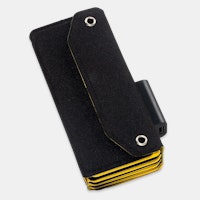Click to view our Accessibility Statement or contact us with accessibility-related questions




Secrets of Sealed

search
close
Sort by: Newest
keyboard_arrow_down
Let’s get the conversation started!
Be the first to comment.
PRODUCTS YOU MAY LIKE
Trending Posts in More Community Picks

Graham88
Completely surprised by the lack of blade diversity here on Drop...
I’ve been a collector of Blades since before my teens, and a retailer coming up on 15… or maybe 20 years. Drop has really been kind of an interesting experience for me, because I do occasionally get to see some unusual tech and sometimes EDC items that otherwise I might not have been aware of. And maybe it’s because I have a deep love of cutlery and bladed weapons, but I find myself trolling through the site looking at it what’s available; and it’s just it’s pretty much the same. And the bladed community here is just always confused me.. every single knife is about the same, they’re almost all drop points and although the handle materials change and brands change.. it’s really just the same knife over and over and over again... occasionally you’ll see a tanto or a slight variant; but rarely… and almost never a serrated blade. And I’m just deeply amazed at this diversion of serrated blades. And I’m just surprised there isn’t more of a request for diversity here.... and I...
Mar 12, 2020
JellyDPhoto
Can we get Sony E-Mount or other mirrorless camera options please..
Would be nice to see some Sony E mount full frame cameras on here. I currently shoot with a A99 and they killed the lense path for better or more option lenses and now is all E-Mount. 🤔
Jan 13, 2020
RayF
There Are Pandas, and Then There Are Pandas.
And this isn't either of them! The Pandas we're talking about here, are watches, not bears. And what got me thinking about them (again) was a link posted this morning by @cm.rook who pointed a few of us to the very attractive (and not terribly priced) Yema "Rallygraph" Panda which, in it's most traditional arrangement, looks like the one on the left, but can also be had in the version on the right: The model on the left is a true Panda, while the model on the right is called a reverse Panda. The reason for that distinction is clear--Panda bears, only come in the first arrangement. Now at this point, everyone should be thinking about the most well-know Panda, The Rolex Panda, which is actually a Daytona, and among Rolex Daytonas, the most famous of which is the Paul Newman Daytona, which was famous first, because it was Paul's, and second because it sold at auction for $17.8 million (US Dollars). The story of that auction is well-known so I'll only...
Nov 8, 2019






Compared to booster draft, sealed deck is slower, but that is not a full description. The most defining difference is that decks in sealed are less streamlined. This does slow the format down, as it is harder to have focused aggressive decks. It also means it is more important for your cards to do work on their own. Synergy does still matter however, but it appears more in small packages of cards working together, rather than overarching themes of an entire deck.
The first part of playing sealed is of course building the deck from your pool. In less competitive environments, such as a prerelease or leagues on Magic Online, you are allowed to change your build in between rounds. I suggest you take advantage of this opportunity, and try changes to the deck as you get more experience with how it plays out. When building at a more competitive tournament, however, the stakes are higher, with a strict time limit to register the deck you have to play in the first game of every match. That makes it important to practice this building process and become familiar enough with the cards to better process this large amount of information efficiently.
Even after you have decided on a build, there is still the opportunity to change during sideboarding between games. It’s a good idea to show your deck to your friends, and get as much input as you can on how to best build it. If you are doing a build on Magic Online, you can send screenshots of your builds to friends on a messenger, or post in forums or subreddits to get feedback. Discussing builds with other players is one of the best ways to improve at sealed deck.
Sometimes I have realized that a different color was actually stronger, and plan to sideboard into that different version of the deck in every match. Other times, there might be other color options that match up better against what your opponent is playing. It is valuable to keep taking time after the build is up to learn all the possible options your pool contains. Another tip is that if you think it is likely you will make major changes like changing colors, to also sleeve up the cards you will swap in, and practice the process of efficiently changing out your deck. For one, there is a limited amount of time in sideboarding, but it is also advantageous not to be obvious if you are dramatically changing your deck. Changing your build mid-match can catch your opponent unaware.
One thing I like to do that helps me be ready to sideboard better is taking notes during the game on what cards I see from my opponent. This makes it easier to think how all the cards in my deck match up. To now get more concrete, let’s look at a Core Set 2019 sealed pool:
Now given that I think I should be playing red and black, I next looked at the cards I felt were almost certain to make my deck on a curve, to get an idea of what the core of the deck would be, so I could better understand how I should fill out the rest:
Sarkhan is trickier to evaluate. At first, you might be excited to open a planeswalker. But then upon critical reading of the card, it does very little to affect the board. I do, however, have a few synergies that make it more interesting: two dragons as well as putting creatures in the graveyard for Isareth or Rise from the Grave. Also, I wondered if I could potentially back it up with removal to steal a game with the ultimate, especially against slower sealed decks. I tried playing with Sarkhan for a few matches in my league, because when it doubt you should try all the rares you can while practicing, since you don’t get as much opportunity to learn about them. Sarkhan was fine in my first game on the play turn 3, but it didn’t feel much better than a 3 drop creature, and then was a total blank in another tight game where I was under pressure. This fail case was too bad, so I think the original instinct to not play the card was correct.
This leaves the following build, where I opted for the extra swamp, as my double colored black cards are cheaper. The mana here is not good, but this seems unavoidable with most of the double colored cards being too powerful to avoid.
Now here’s a second example pool:
The last thing I would consider in the build are other secondary color options. Red is very short on playables, and it was immediately clear the RW would be a worse option than either of the above decks. The other reasonable contender would be green:
This deck played out quite well as expected, finishing 5-0 in my league. I played many games with both builds of Blue-White, trying to see if the Skilled Animators were worth it. The Animator was solid most games I drew it, but my opponents were able to deal with the 5/5 often, and I had to mulligan some hands without the target. Inspired Charge with Leonin Warleader was the real all-star as expected, so I think the first build that tries to just maximize that without other risky plans would be better in general.
Thank you for reading, and I hope it was informative to hear my thought process as I dissect a pool. Let me know how you would have handled these two builds, as there were many subtle decisions to be made. Finally, I’ll be at Grand Prix Sacramento this weekend putting this knowledge to the test, feel free to come say hi if you’ll be there too!
Previous Articles · Meet the Massdrop Teams: http://dro.ps/mtg-team-announce · *2nd* at Pro Tour Ixalan: http://dro.ps/ixalan · Unclaimed Creature Types: http://dro.ps/ari-creatures · Why I Never Drop From Tournaments: http://dro.ps/eric-nevergiveup · The Art of Sideboard Construction - Sultai Energy: http://dro.ps/jon-sideboard · A Commoner’s View on Pauper: http://dro.ps/mark-pauper · Blue Moon Beach Control: http://dro.ps/scott-bluemoon · Top 5 Modern Decks: http://dro.ps/pascal-modern · Storm in Vintage Cube: http://dro.ps/ben-storm · An Early Look at Rivals for Standard: http://dro.ps/shaun-rivals · A Standard Approach to Evaluating New Cards: http://dro.ps/rob-newcards · Drafting Rivals of Ixalan: http://dro.ps/tim-ixalan · Team Sealed Secrets: http://dro.ps/eric-secrets · Steal My Standard Ideas: http://dro.ps/tommy-secrets · Vexing Devil. Any Questions?: http://dro.ps/jon-devil · Team Massdrop Rivals of Ixalan Limited Primer: http://dro.ps/ari-primer · Gestation of RG Eldrazi: http://dro.ps/ben-gestation · Top Tim Tournament Training Tips: http://dro.ps/tim-tips · What Makes Someone Bogle?: http://dro.ps/tommy-bogle · A Pauper Adventure: http://dro.ps/pascal-pauper · Blue Moon at GP Phoenix: http://dro.ps/rob-bluemoon · Brawling into Dominaria: http://dro.ps/scott-brawling · Looking at The Current Lands(cape) of Legacy http://dro.ps/jarvis-land · Deconstructing Dominaria Limited: http://dro.ps/jon-dominaria · Diving into Dominaria Standard: http://dro.ps/mark-dominaria · What are your.. drives?: http://dro.ps/tommy-drives · Top 10 Cards for Dominaria Modern: http://dro.ps/rob-dominaria · Brewing Standard with Dominaria: http://dro.ps/pascal-dominaria · Dominaria Team Sealed: A Case Study: http://dro.ps/tim-dominaria · Battlebonding in Vintage and Legacy: http://dro.ps/jarvis-battlebond · Decks I Almost Played at PT Dominaria: http://dro.ps/ben-dominaria · RB Chainwhirler for the Non-Aggressive Player: http://dro.ps/jon-chainwhirler · Top 4 at GP Vegas: http://dro.ps/mark-top4vegas · Return to Core Set Limited: http://dro.ps/eric-core · Drafting Rares with Core Set 2019: http://dro.ps/ari-core · Tuning Jeskai Control in Modern: http://dro.ps/shaun-jeskai